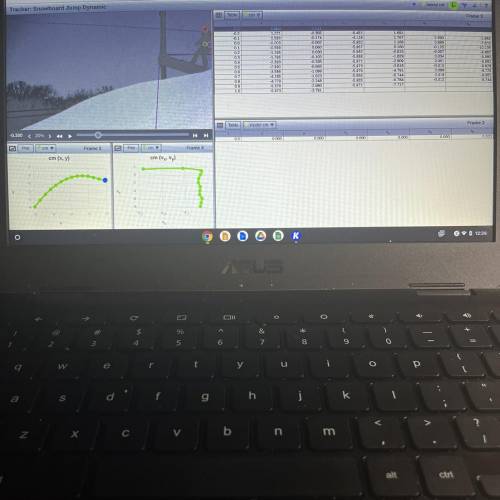Please help!! giving have not been able to find help!
Task 3
Modeling the Snowboarder's Mot...

Physics, 07.02.2022 01:00 zaygonegraduate
Please help!! giving have not been able to find help!
Task 3
Modeling the Snowboarder's Motion
In this kinematics unit activity, you won't use forces, but just describe the snowboarder's position over time. An analytic model is designed to do just
that.
You have traced the motion of the snowboarder using his center of mass as the point of reference. Now, consider the snowboarder as a whole and try
to model his motion mathematically.
With Tracker, you can create either an analytic particle model or a dynamic particle model for the snowboarder. An analytic particle model helps trace
the motion using the mathematical expressions for the positions of the object in motion. In a dynamic model, you set the initial conditions, like position
and velocity, and then you mathematically define the forces acting on that system.
Before creating the analytic model, though, you'll need to figure out how the x and y positions vary with time. You'll need mathematical expressions for
this to build your model. Answer the following questions to figure that out
Part A
The general kinematic equations of motion for horizontal displacement can be simplified significantly for this motion. Write the simplified
equation for x in this case. Explain how you have been able to simplify it from this general displacement equation:
Part C
Now, to get numerical equations for x and y, you'll need to know the initial values (at time t = 0) for some velocities and accelerations. On the Table
below the video:
• Select cm as the mass measurement set to display.
. Click the Table label and check all x and y displacement and velocity data: x y, vx, and yy. Then click Close.
Now rewrite the displacement equations from Part A and Part B above by substituting in the x and y velocity values from time t= 0 and also using
the theoretical value of acceleration of gravity. Write them out below.
Part D
Describe in what way the position of the modeled point varies from the center of mass point. Specifically, in the last frame, in what direction does
it lie from the center of mass point?
Assuming the variation is due to small inaccuracies in the initial velocity values in the table, how would you have to modify the initial vx and Vy
values to get closer to the observed motion?
Now, refer to the Tracker Help to see how to define an analytic model in the Model Builder. There, you'll need to:
• Create an Analytic Particle Model
• Select a color for this measurement different from the four other measures (like a bright blue)
• Enter the mass of the snowboarder in kg. (See the first frame of the video for that information.)
• Enter the initial time. Since we're modeling the projectile motion part of the run, begin with time t=0.0.
• Enter the expressions you developed in (c) above for the horizontal and vertical displacements. Note that you'll need to use symbols similar
to those used in a spreadsheet for multiplication (*), division (/), and exponents (^).
After you create your analytic model, run the video. Due to the short time intervals in this video (0.1 seconds) and the difficulty of measuring
closer than a couple of centimeters for any point on the snowboarder's body in the video, the instantaneous velocities recorded in the table for
any given point might be off by as much as 10 centimeters per second (0.1 meters/second). This is really just a measurement variation of one
centimeter on the snowboarder's body in the 0.1 second time interval. If a point measurement is off by one or two pixels in this video, you'll see
that much variation in instantaneous velocity for an individual point.
Part E
Try some slightly different values for both Initial velocities (V, and vy) and test them against the center of mass point by running the video. Your
test values should not differ from the table values by more than 0.100 meters/second. Once you are satisfied with your model, record model
values and expressions in the table below.
Modeled Variable-
Expression -
(Initial) Vx
(Initial) Vy
Parameter: m
Initial value: t
Position function: x
Position function:y
Part F
Imagine you were a sportscaster at the Olympics. Youd created a mathematical model similar to the one you just did. Imagine that you had a
computer program that could do an instantaneous analysis of video motion using that model. How could you use it in your sportscast?


Answers: 3


Another question on Physics

Physics, 22.06.2019 03:50
Two polarizers are oriented at 70∘∘ to one another. unpolarized light falls on them. what fraction of the light intensity is transmitted?
Answers: 1

Physics, 22.06.2019 07:00
Oxygen and hydrogen gas are at the same temperature t.what is the ratio of kinetic energies of oxygen molecule and hydrogen molecule if oxygen is 16 times heavier than hydrogen.
Answers: 3

Physics, 22.06.2019 21:00
Ascientist wants to test ways to reduce pollution in lake . what is the bestway of doing this
Answers: 2

Physics, 22.06.2019 22:30
Suppose astronomers built a 140-meter telescope. how much greater would its light-collecting area be than that of the 10-meter keck telescope? express your answer using two sign
Answers: 3
You know the right answer?
Questions

Physics, 17.12.2019 16:31


Health, 17.12.2019 16:31


Computers and Technology, 17.12.2019 16:31


History, 17.12.2019 16:31



Mathematics, 17.12.2019 16:31



History, 17.12.2019 16:31

Mathematics, 17.12.2019 16:31

Social Studies, 17.12.2019 16:31



Physics, 17.12.2019 16:31

Mathematics, 17.12.2019 16:31



